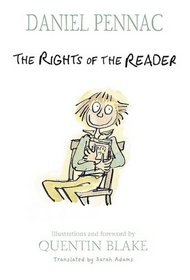Helpful Score: 1
Reviewed by Marta Morrison for TeensReadToo.com
THE RIGHTS OF THE READER is translated from French, which Daniel Pennac wrote in 1992. Pennac was an inner-city teacher in Paris. He believes that we need to promote reading for pleasure in order to get our young ones to read.
He relates many stories from his own time spent growing up and teaching. He believes in the power of the story. He thinks that when children are asked to answer comprehension questions when learning to read, all their love of reading disappears.
I really think he is on to something here. I teach fifth grade and read aloud all the time. Since the No Child Left Behind act has become law, I haven't had as much time to read aloud as I did before. I have so many standards to teach and especially in California where they are so high, that reading aloud time has been drastically cut. I loved this book because it validated what I believe.
He also wrote ten rights of the reader:
1. The right to read. I liked this right because even though I am a reader there are times when I don't read because life has gotten to me. I remember a real sparse time after the birth of both of my kids. I didn't crack a book for about nine months.
2. The right to skip.
3. The right not to finish a book. This hit home with me, too. I always felt guilty when I didn't finish a book for a book club, but I have the right not to finish a book whenever I don't like it.
4. The right to read it again - Harry Potter, here I come!
5. The right to read anything.
6. The right to mistake a book for real life.
7. The right to read anywhere. This applies to me since I have read many times in Disneyland - and I have pictures to prove it.
8. The right to dip in.
9. The right to read out loud.
10. The right to be quiet and not discuss the book with anyone.
I enjoyed THE RIGHTS OF THE READER a lot and recommend it to all who are readers or who work with children.
THE RIGHTS OF THE READER is translated from French, which Daniel Pennac wrote in 1992. Pennac was an inner-city teacher in Paris. He believes that we need to promote reading for pleasure in order to get our young ones to read.
He relates many stories from his own time spent growing up and teaching. He believes in the power of the story. He thinks that when children are asked to answer comprehension questions when learning to read, all their love of reading disappears.
I really think he is on to something here. I teach fifth grade and read aloud all the time. Since the No Child Left Behind act has become law, I haven't had as much time to read aloud as I did before. I have so many standards to teach and especially in California where they are so high, that reading aloud time has been drastically cut. I loved this book because it validated what I believe.
He also wrote ten rights of the reader:
1. The right to read. I liked this right because even though I am a reader there are times when I don't read because life has gotten to me. I remember a real sparse time after the birth of both of my kids. I didn't crack a book for about nine months.
2. The right to skip.
3. The right not to finish a book. This hit home with me, too. I always felt guilty when I didn't finish a book for a book club, but I have the right not to finish a book whenever I don't like it.
4. The right to read it again - Harry Potter, here I come!
5. The right to read anything.
6. The right to mistake a book for real life.
7. The right to read anywhere. This applies to me since I have read many times in Disneyland - and I have pictures to prove it.
8. The right to dip in.
9. The right to read out loud.
10. The right to be quiet and not discuss the book with anyone.
I enjoyed THE RIGHTS OF THE READER a lot and recommend it to all who are readers or who work with children.




![header=[] body=[Get a free book credit right now by joining the club and listing 5 books you have and are willing to share with other members!] Help icon](/images/question.gif?v=073053df)
